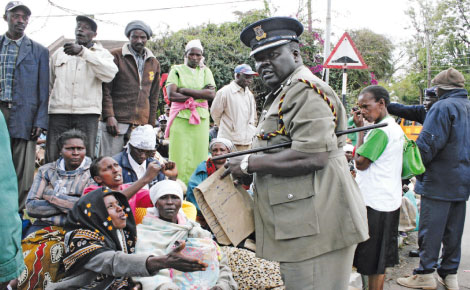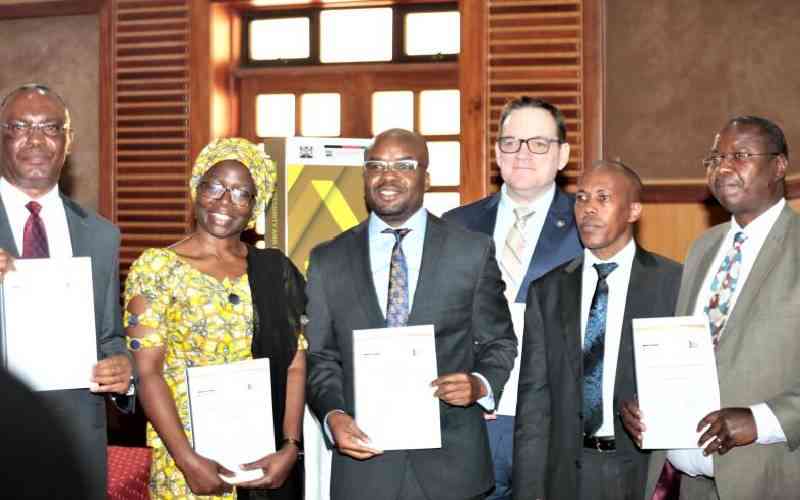 |
|
Kilimani police boss Peter Katam addresses internally displaced persons who had camped along State House Road on December 4 demanding to be addressed by the President. [Photo:Standard] |
By Machua Koinange
Kenya: At about 10pm on December 26, just a day after Christmas, a man was entertaining guests at his Kilimani home when the security guard rang his door bell.
He responded to the door only to find the regular security guard and a gentleman carrying a police radio in one hand. He panicked. Was there an emergency? Had he broken the law?
The guest clad in a black leather jacket introduced himself as Peter Katam, the officer commanding Kilimani Police Division.
After introducing himself, he requested to be allowed in to talk to the guests about community policing.
The man of the house, who we shall call Paul Mbereri, was astounded by Katam’s calm and polite demeanour—a departure from the usual rude and harsh tone used by some officers.
For weeks now, Katam has been going round Kilimani introducing himself to residents and informing them of his new role of getting the community to meet the officers who provide security in their area.
Mbereri warmly welcomed the officer into the backyard where he and his visitors were having a barbecue around a fire. His wife ordered food and nyama choma for the officer and a similar dish for the OCPD’s driver who was parked at the gate.
It turned out that Katam had seen vehicles parked at the residence and took the opportunity to spread the gospel of community policing. As fate would have it, he ended up interacting with the group for more than two hours.
The fireside banter about security and the relationship between the police and residents was spiced up by loud jokes and iced by regular sessions of loud laughter.
“It was the closest I have come to being with law enforcement without anger or being accused of a traffic offence. The interaction with Katam taught me that police officers were just like us, only with a tougher job to do,” said one of the guests.
Before leaving the party, Katam gave the guests his personal cell phone number.
“Security is not a preserve of the police. The public must be engaged to understand how they can work with us,” said Katam as he shared his unique method with The Standard.
Suspicious individuals
He is not alone. Many OCPD’s and Officers Commanding Stations across the country are reading from this same script and enlisting the community to help track down criminals and report suspicious individuals in their area. The Kenya Police Service has already drafted a community policing manual under the Interior Coordination Ministry.
Stay informed. Subscribe to our newsletter
What makes community policing different from the Nyumba Kumi initiative is that besides just knowing your next 10 neighbours’ full names and what they do for a living, residents are being encouraged to interact with the police and provide crucial leads that can help track down criminals and enable police respond to emergencies faster.
The community policing programme is expected to be rolled out nationwide soon and could play a crucial role in curtailing crime. According to a draft of the community policing (CP) programme seen by The Standard, the latter is a creation of the Constitution.
The supreme law demands the establishment of partnerships, promotion of communication and co-operation to fulfill policing needs for communities.
Regular visits
The programme has the backing of the National Police Service Commission, the Government of Sweden (through the Swedish National Police Board), the Kenya Institute of Curriculum Development (KICD) and the Institute of Police Education of Linnaeus University.
Kilimani is one area where the concept is already showing results. Officers in the division work closely with the local community. This has partly been necessitated by regular visits to police stations by residents to interact with the police.
Katam says he encourages his officers to develop rapport with the public and be professional and polite when dealing with wananchi.
“It is the public that can provide us with crucial leads to an investigation or help foil criminal plans. The information we gather from the public helps us to stay one step ahead of the criminals,” he says.
In mid-last year, criminal gangs masquerading as boda boda operators were carjacking and robbing motorists and pedestrians along the Ring Road Kilimani by-pass connecting Yaya centre to James Gichuru Road by blocking them.
Through the CP initiative, Katam was able to gather crucial information about the origin of the gangs from a nearby slum and began tracking them down.
By October, police had gunned down two of the gang members and the rest fled closing a terror chapter in Kilimani.
CP works in various ways. Police not only give out their numbers but also regularly call residents to find out what is happening. Sharing of information has proved very crucial to make CP work.
Joseph Ndung’u, a security expert who heads a training school that provides high level training to police officers says CP has worked remarkably well in Sweden, one of the countries in the world with low crime rates.
“Sharing crime prevention with the public is effective to fight crime waves and reduce terrorism. The tactic is part of county policing, Part Six of the National Police Service Act 2011, that needs to be implemented. It allows for the setting up of six-member county security committees composed of the public and police,” he says.
Gazette notice
A county security committee becomes operational only after the Inspector General of Police issues a gazette notice.
Two years after the National Police Service Act was gazetted, county security committees are yet to come into force.
However, some police stations have taken their own initiative to fight crime via community policing.
In Othaya, former area police boss Adiel Nyange gave his personal cell phone to area residents so that they could call him during emergencies.
Adiel says as a policy, giving out his personal number builds trust with the community and helps police keep track of events.
 The Standard Group Plc is a
multi-media organization with investments in media platforms spanning newspaper
print operations, television, radio broadcasting, digital and online services. The
Standard Group is recognized as a leading multi-media house in Kenya with a key
influence in matters of national and international interest.
The Standard Group Plc is a
multi-media organization with investments in media platforms spanning newspaper
print operations, television, radio broadcasting, digital and online services. The
Standard Group is recognized as a leading multi-media house in Kenya with a key
influence in matters of national and international interest.
 The Standard Group Plc is a
multi-media organization with investments in media platforms spanning newspaper
print operations, television, radio broadcasting, digital and online services. The
Standard Group is recognized as a leading multi-media house in Kenya with a key
influence in matters of national and international interest.
The Standard Group Plc is a
multi-media organization with investments in media platforms spanning newspaper
print operations, television, radio broadcasting, digital and online services. The
Standard Group is recognized as a leading multi-media house in Kenya with a key
influence in matters of national and international interest.









